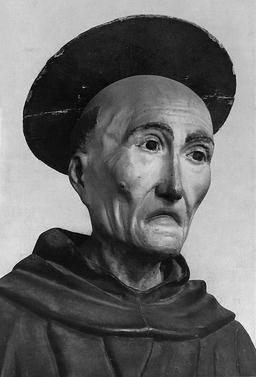The text shows the oldest list of Trionfi with names for single trumps, indicating a row. A picture of the page is given in Stuart Kaplan, Tarot Encyclopedia I, p XVI (beside page 1).
In the past it was reported in various Tarot history books about the text with contradictions. The dating was given in different forms between 1450 - 1500, as writer was considered either a Dominican or a Franciscan monk.
A personal letter to Ron Decker, between 1991 and 2001 the curator United States Playing Card Company, which owns the manuscript, reached the following information: "The manuscript pages have many different watermarks. All of them date from around 1500 and come from places near Ferrara. The order of the Tarot trumps, as given in the manuscript, is the Ferrarese order. The author was definitely a monk. One of the sermons is about the stigmata of St. Francis, so I think it likely that the monk was a Franciscan. I do not know on what basis others have declared the author to have been a Dominican." (Ronald Decker)
The original (shown by Kaplan) uses abbreviations, which are given in full length in the transription. The List text is:
Primus dicitur El bagatella (et est omnium inferior). 2, Imperatrix. 3, Imperator. 4, La papessa (O miseri quod negat Christiana fides). 5, El papa (O pontifex cur, &c. qui debet omni sanctitate polere, et isti ribaldi faciunt ipsorum capitaneum). 6, La temperantia. 7, L'amore. 8, Lo caro triumphale (vel mundus parvus). 9, La forteza. 10, La rotta (id est regno, regnavi, sum sine regno). 11, El gobbo. 12, Lo impichato. 13, La morte. 14, El diavolo. 15, La sagitta. 16, La stella. 17, La luna. 18, El sole. 19, Lo angelo. 20, La justicia. 21, El mondo (cioe Dio Padre). 0, El matto sie nulla (nisi velint).

San Bernardino, a Franciscan monk, preached against card playing in the 20ies of 15th century in all Italy. St Capristan, another Franciscan and his follower, did the same in Germany 1454, collecting militaric forces for a crusade. The opposition again card playing was proceeded by the unknown Franciscan monk, who wrote the Sermones de Ludo cum aliis at the end of the century.
----------------------------------
The picture shows a sculpture of San Bernardino by Lorenzo di Pietro detto il Vecchietta
(Castiglion dell'Orcia 1412 circa - Siena 1480)
It's plausible, that the young Vecchietta knew the living old San Bernardino.